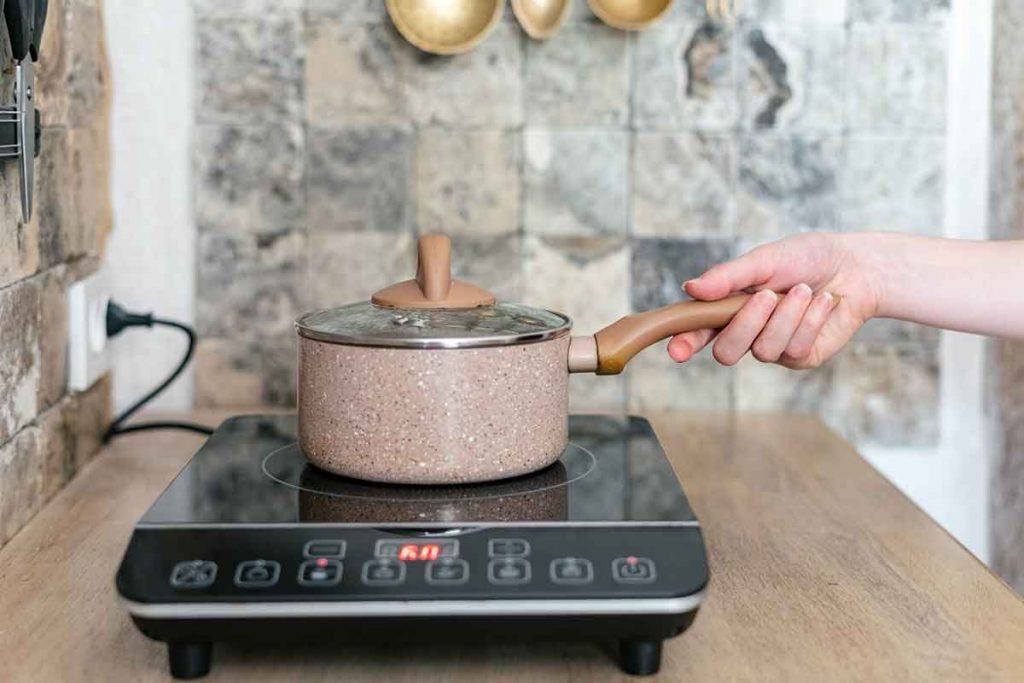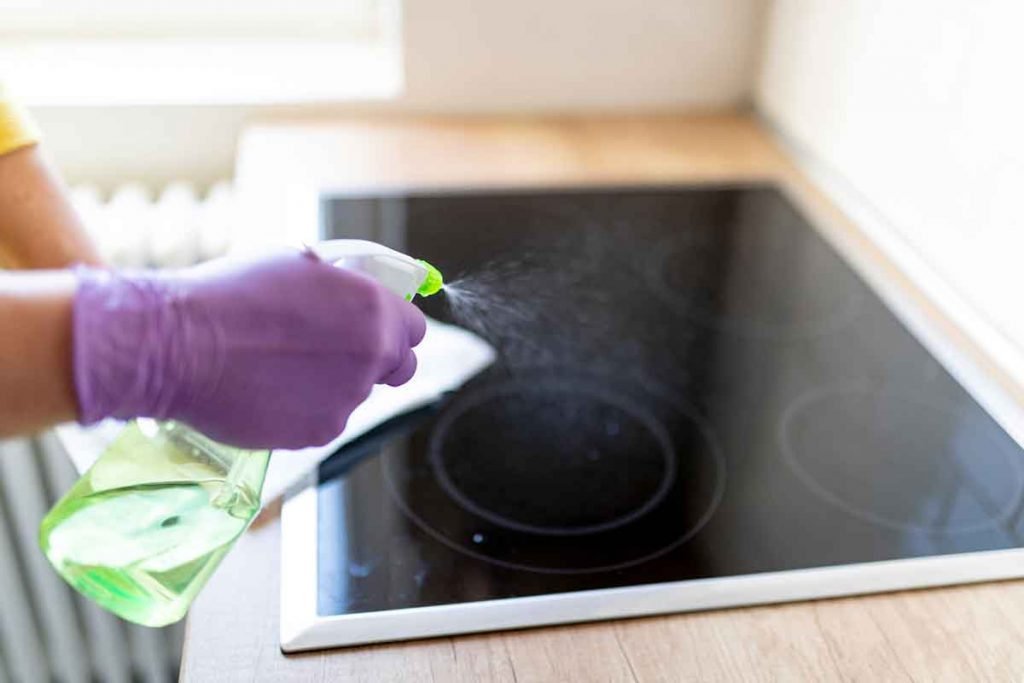Let’s put it in a simple way: you can plug your cooktop into a socket, but it must be compatible with the stove’s power consumption rating. But generally, it’s potentially dangerous, so we’d recommend that you don’t.
Let’s dig deeper into this topic and see the reasons why we advise you against it unless your home’s electric circuit and wiring are compatible with the stove’s power consumption capacity.
So, Can I Plug Other Appliances into a Socket While Using an Induction Cooktop?
Plugging other appliances into the socket supplying power to your induction stove is potentially dangerous, so don’t. Every additional appliance plugged into the socket increases the wattage (the amount of electricity) passing through it. To this end, too many appliances in a socket can overload it, causing it to blow and potentially damaging the connected appliances or even sparking a fire.
Induction stoves have considerably high wattage ratings, ranging between 800 and 3,000 watts. To this end, it requires a dedicated outlet, meaning you shouldn’t plug in any other appliances.
Do Induction Cooktops Need Any Special Wiring?
Besides a compatible socket, induction stoves also need compatible wiring. Compatibility comes down to the wires’ size and material, which determine how many amps they can handle.
Wires generate some resistance against the electric current flowing through them, ensuring that it flows in the right direction. The resistance generates energy, which in turn generates heat. The resistance can be high or low, depending on the wire’s diameter and the amps passing through it. Naturally, too much resistance generates more heat, damaging the wires or even sparking a fire.
Amperage requirements for induction stoves vary, depending on the type and size, and range from 20 to 48 amps. With this in mind, here is an overview of the standard wiring measurements and their amperage ratings:
- 6-Gauge – 55 amps.
- 8-Gauge – 40 amps.
- 10-Gauge – 30 amps.
- 12-Gauge – 20 amps.
- 14-Gauge – 15 amps.
To this end, you need a 12-gauge wire to support an induction stove with the lowest amperage rating. Overall, 8-gauge wiring is recommended for all induction cooktops – remember to check whether your preferred gauge is permitted under local building codes. Interestingly, most homes have main panels that can support 150 to 200 amps, which is more than enough to support any induction stove’s amperage.
Besides size, the wiring material also matters. Copper and aluminum are the most common wiring materials. However, copper is the recommended wiring material for two important reasons.
First, induction stoves use copper wiring, which is incompatible with aluminum wiring. As such, you would need a special connector to connect the stove to an outlet powered by aluminum wiring.
Second, aluminum wiring expands more than copper wiring when heated, causing loose connections at screw terminals and disrupting the stove’s power supply. Heating is a big problem, considering that induction stoves have much higher wattage, voltage, and amperage ratings than other high-power appliances. Fortunately, you may not need to change your home’s wiring, considering that aluminum wiring is illegal in most places.
What’s the Correct Connection for an Induction Cooktop?
Now, to answer the main question: can you plug an induction cooktop into a socket? You can, but it must be a dedicated and grounded 220V-240V outlet. However, some portable induction stoves are rated for 110V, making them compatible with standard power outlets (like those used with gas stoves).
Additionally, the outlet should feature circuit breakers rated for 40-50 amps to protect it from power surges. The breakers should terminate in an approved junction box, which should be strategically located (about 16 inches below the cooktop’s underside) away from exposure to excess heat generated by the cooktop.
You can inspect your home’s sockets, circuits, and wiring to see whether they are compatible with the induction stove. However, the details can be confusing for ordinary people without a background in the field, so call a professional technician whenever in doubt.
Do You Need Three-Phase Power for an Induction Cooktop?
You don’t necessarily need a three-phase power connection for an induction cooktop. A single-phase connection is sufficient to handle all standard induction stoves’ power supply requirements, including those rated for up to 230V.
However, a three-phase connection is necessary when using other high-power appliances, such as HVAC units, washers, and dryers. A three-phase power connection can handle at least 400 volts, which is sufficient to support most major appliances, including a high-power induction stove.
Installing a three-phase power connection can be expensive and may require extensive modifications to your home’s circuit. Fortunately, you can install a phase converter to upgrade your home’s single-phase connection to support three-phase appliances.
Wrapping Up
Plugging an induction stove into an incompatible socket is potentially dangerous. As such, check whether the socket and wiring can support your stove’s power requirements before plugging in your stove. You may need to upgrade the socket and wiring if they can’t support the stove’s power requirements. Finally, always call a professional technician whenever in doubt.
Frequently Asked Questions
Can You Plug an Induction Cooktop Into a Regular Electrical Socket?
No. Induction cooktops typically require a dedicated electrical circuit and outlet due to their higher power requirements. They often need a 240-volt electrical outlet with a higher amperage rating than standard household outlets.
What Kind of Electrical Setup is Needed for an Induction Cooktop?
Induction cooktops usually require a 240-volt, 30-50 amp circuit. This setup provides the necessary power to generate the magnetic fields required for induction cooking. It’s recommended to consult an electrician to ensure your electrical system is suitable for the cooktop’s power needs.
Can You Use an Extension Cord for an Induction Cooktop?
It’s generally not recommended to use an extension cord with an induction cooktop, as the higher power draw could potentially overload the extension cord and create a safety hazard. It’s safer to have a dedicated outlet installed by a professional electrician.
Can You Use an Induction Cooktop in a Regular Kitchen Outlet if You Have an Adapter?
Using an adapter to plug an induction cooktop into a standard household outlet is not recommended. Induction cooktops require more power than regular outlets can provide, and attempting to use an adapter could lead to inadequate power supply, reduced performance, or electrical issues.
Can You Use a Generator to Power an Induction Cooktop During a Power Outage?
Using a generator to power an induction cooktop during a power outage is possible, but it requires a generator with sufficient wattage and voltage capabilities to match the cooktop’s requirements. It’s important to consult the cooktop’s manual and the generator’s specifications to ensure compatibility and safety.



